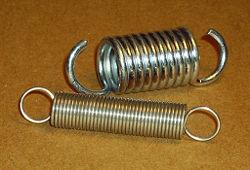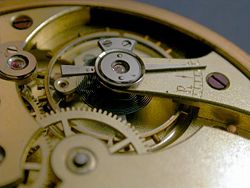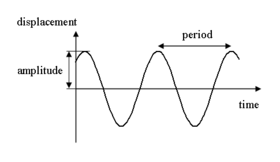Difference between revisions of "Spring (device)" - New World Encyclopedia
(New page: {{otheruses|Spring}} thumb|right|250px|[[Helix|Helical or ''coil'' springs designed for tension]] A '''spring''' is a flexible elastic object used...) |
|||
| Line 1: | Line 1: | ||
| + | {{Claimed}}{{Images OK}}{{Submitted}}{{Approved}} | ||
{{otheruses|Spring}} | {{otheruses|Spring}} | ||
[[Image:Springs 009.jpg|thumb|right|250px|[[Helix|Helical]] or ''coil'' springs designed for tension]] | [[Image:Springs 009.jpg|thumb|right|250px|[[Helix|Helical]] or ''coil'' springs designed for tension]] | ||
| Line 78: | Line 79: | ||
==External links== | ==External links== | ||
| − | |||
*[http://www.allrite.com/helix.html Left Hand Versus Right Hand Wound Springs] | *[http://www.allrite.com/helix.html Left Hand Versus Right Hand Wound Springs] | ||
| Line 92: | Line 92: | ||
*[http://www.springmasters.com/spring-terminology.html Spring Terminology] | *[http://www.springmasters.com/spring-terminology.html Spring Terminology] | ||
| − | [[Category: | + | [[Category:Physical sciences]] |
| + | [[Category:Physics]] | ||
| − | {{ | + | {{credit|132002086}} |
| − | |||
| − | |||
| − | |||
| − | |||
| − | |||
| − | |||
| − | |||
| − | |||
| − | |||
| − | |||
| − | |||
| − | |||
| − | |||
| − | |||
| − | |||
| − | |||
| − | |||
| − | |||
| − | |||
| − | |||
| − | |||
| − | |||
| − | |||
Revision as of 15:31, 25 May 2007
- For other uses, see Spring (device) (disambiguation).
A spring is a flexible elastic object used to store mechanical energy. Springs are usually made out of hardened steel. Small springs can be wound from pre-hardened stock, while larger ones are made from annealed steel and hardened after fabrication. Some non-ferrous metals are also used including phosphor bronze for parts requiring corrosion resistance and beryllium copper for springs carrying electrical current (because of its low electrical resistance).
Types
The most common types of spring are:
- Coil spring or helical spring - a spring (made by winding a wire around a cylinder) and the conical spring - these are types of torsion spring, because the wire itself is twisted when the spring is compressed or stretched. These are in turn of two types:
- Tension springs are designed to become longer under load. Their turns are normally touching in the unloaded position, and they have a hook, eye or some other means of attachment at each end.
- Compression springs are designed to become shorter when loaded. Their turns are not touching in the unloaded position, and they need no attachment points. A volute spring is a compression spring in the form of a cone so that under compaction the coils are not forced against each other, thus permitting longer travel.
- Leaf spring - a flat springy sheet, used in vehicle suspensions. electrical switches, bows.
- V-spring - used in antique firearm mechanisms such as the wheellock, flintlock and percussion cap locks.
- Spiral spring or 'clock spring' - a spring of the type as used in clocks, galvanometers, and places where electricity must be carried to partially-rotating devices such as steering wheels.
- Cantilever spring - a spring which is fixed only at one end.
Other types include:
- Belleville washer or Belleville spring - a disc shaped spring commonly used to apply tension to a bolt (and also in the initiation mechanism of pressure-activated landmines).
- Spring washer - used to apply a constant tensile force along the axis of a fastener.
- Torsion spring - any spring designed to be twisted rather than compressed or extended.
- Gas spring - a volume of gas which is compressed.
- Rubber band - a tension spring where energy is stored by stretching the material.
Physics
Hooke's Law
Springs that are only stretched or compressed slightly obey Hooke's law, which states the force with which the spring pushes back is linearly proportional to the distance from its equilibrium length:
where
- x is the distance the spring is elongated by,
- F is the restoring force exerted by the spring, and
- k is the spring constant or force constant of the spring.
Simple harmonic motion
Since force is equal to mass, m, times acceleration, a, the force equation looks like:
But acceleration is just the second time derivative of x, so
Re-arranging results in a differential equation
the solution of which is the sum of a sine and cosine:
The graph of this function is displayed in the image on the right.
Theory
In classical physics, a spring can be seen as a device that stores potential energy by straining the bonds between the atoms of an elastic material.
Hooke's law of elasticity states that the extension of an elastic rod (its distended length minus its relaxed length) is linearly proportional to its tension, the force used to stretch it. Similarly, the contraction (negative extension) is proportional to the compression (negative tension).
This law actually holds only approximately, and only when the deformation (extension or contraction) is small compared to the rod's overall length. For deformations beyond the elastic limit, atomic bonds get broken or rearranged, and a spring may snap, buckle, or permanently deform. Many materials have no clearly defined elastic limit, and Hooke's law can not be meaningfully applied to these materials.
Hooke's law is actually a mathematical consequence of the fact that the potential energy of the rod is a minimum when it has its relaxed length. Any smooth function of one variable approximates a quadratic function when examined near enough to its minimum point; and therefore the force — which is the derivative of energy with respect to displacement — will approximate a linear function.
Contrary to popular belief, springs do not appreciably "creep" or get "tired" with age. Spring steel has a very high resistance to creep under normal loads. The sag observed in older automobiles is really due to the springs being occasionally compressed beyond their yield point, causing plastic deformation. This can happen when the vehicle hits a large bump or pothole, especially when heavily loaded. Most vehicles will accumulate a number of such impacts over their working life, leading to a lower ride height and eventual bottoming-out of the suspension.
Toys
Wikibooks modules
External links
Credits
New World Encyclopedia writers and editors rewrote and completed the Wikipedia article in accordance with New World Encyclopedia standards. This article abides by terms of the Creative Commons CC-by-sa 3.0 License (CC-by-sa), which may be used and disseminated with proper attribution. Credit is due under the terms of this license that can reference both the New World Encyclopedia contributors and the selfless volunteer contributors of the Wikimedia Foundation. To cite this article click here for a list of acceptable citing formats.The history of earlier contributions by wikipedians is accessible to researchers here:
The history of this article since it was imported to New World Encyclopedia:
Note: Some restrictions may apply to use of individual images which are separately licensed.








